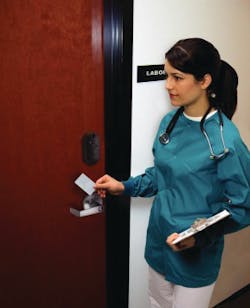The security industry is hot right now and with dealers and other industry professionals striving to get the most profit for each of their businesses, competition is stronger than ever and there's no margin for error. And when it comes to access control solutions, each group is trying to figure out how to install more doors faster at a lower overall cost. While the concept of wireless is not new, the technology is more reliable, signal strength and battery life is up and new applications abound. Proposing a wireless access control solution can often tip the job to the dealers experienced in wireless systems-both in retrofit and new construction applications.
Cut installation costs with wireless
Implementing wireless access control reduces installation time by up to 50 percent, system costs by up to 25 percent or more, and minimizes disruption to the facility during installation. With no wire to pull or trenches to dig, a wireless access control solution takes about 45 minutes to install versus an average of eight hours for a wired solution. These systems are less invasive, often eliminating carpentry, patching and repainting. This makes them ideal for both difficult to wire upgrade situations and new projects.
The elimination of wire also creates material savings in addition to tremendous labor savings. As a result, one dealer can present estimates lower than other dealers promoting only wired alternatives or, for the same budget, extend the customer's card-based access control system to more openings.
Even remote doors can benefit
How often has your dealer run into this situation? An organization has a state-of-the-art hardwired, open architecture access control system that is integrated with their alarm and video systems. They use cards to access their doors. But, if you go to their remote buildings-such as storage sheds or power facilities-they are accessed with keys, even padlocks. Why? It would cost too much to pull wire or dig trenches to extend card reading to these buildings.
A hospital is one example where this scenario can occur. Quite often, the maintenance shed, which houses snow plows, lawn mowers, tools and other supplies, is located on the periphery of the hospital's grounds. This equipment is not cheap and easy to resell. Wouldn't it make sense for the employees, who use cards elsewhere on the property, to use their cards here? Wouldn't that be more secure? In case of a theft, wouldn't it be nice to have an audit trail?
The same could be said of the guard booth at the entrance and the hospital's other remote buildings. With wireless, all remote door applications can all use the same card access control system deployed by the rest of the organization. For the same price as a wired system, you're providing more security at more doors with wireless.
The bottom line is solid
With wireless coverage across more doors, the process is simpler and lets integrators avoid the time-consuming challenge of pulling and charging for wire and hiring contractors to dig trenches. That money can instead be spent on more hardware, extending customers' systems and the dealer's revenue and profit.
Sean Leonard is the portfolio marketing director for Ingersoll Rand Security Technologies, Carmel, Ind.
